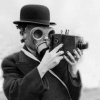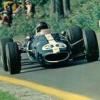The Grand Prix Medical Unit & Louis Stanley
#1

Posted 22 December 2004 - 20:03
this is my first entry. Therefore I would like to introduce myself. My name is Tom. I'm 35 years old and interested in historical racing. I live in the proximity of the Nuerburgring and photograph there very much.
But now to my question: Louis Stanley the boss of BRM created 1970 the "Grand_Prix_Medical_Unit". I read, that the "Grand_Prix_Medical_Unit" was financially supported by 12 formula 1 drivers.
Which 12 drivers were that?
Does someone have a photo of the "Grand_Prix_Medical_Unit"?
Thank you
Tom
Advertisement
#2

Posted 22 December 2004 - 21:14
All I know about Louis Stanley work on the Grand Prix Medical Unit is that in 1967, Louis Stanley founded the Grand Prix Medical Service, with support from the GPDA.
It consisted of mobile medical units that were used on several European circuits because some of them refused to use them because it was not affiliated to the FIA.
I look forward to hear from you about your stories or photographs about the Nurburgring in the future as I am quite a big fan of the circuit itself.
#3

Posted 22 December 2004 - 21:21
#4

Posted 22 December 2004 - 22:25
Mind you, Tom has shown a degree of initiative in order to source his answer. The question is, will we help him...?!
#5

Posted 22 December 2004 - 22:43
I went through there the other day for the first time in ages. I remember whenever going past Lou's house as a kid on the school bus, you would more often than not see him on the phone as he had his desk right by the window facing the street in his first floor office. Quite often, famous racing personalities would visit Lou's house and would dine in the nearby pub/restaurant. I would hear of who had visited the pub as my mother worked there!
#6

Posted 22 December 2004 - 22:48
Is it in a museum somewhere, or is it perhaps a restoration project waiting to happen ?
Assuming that it still exists of course......
#7

Posted 22 December 2004 - 23:33
DCN
#8

Posted 22 December 2004 - 23:59
Originally posted by Doug Nye
...somewhere in the sands of the desert, or upon ground once trodden by H.M. Stanley in search of Dr Livingstone, I presume....? The vehicle was turned into cash long, long ago, and somewhat to the surprise of its sponsors, donors, and probable owners...
DCN
What a shame. As a commercial venture I have been thinking of setting up a mobile vasectomy service. Big Lou's vehicle would have been perfect.
I think it was at Clermont Ferrand one year that the Stanleys threw a wobbler when their precious bit of super-sterile surgical kit was sited (by race organisers) in the midst of a rubbish tip...
#9

Posted 23 December 2004 - 07:31
>All I know about Louis Stanley work on the Grand Prix Medical Unit is that in 1967,
I also found that at a book and the internet (http://www.btinterne...bs/timeline.htm)
1970 in Monza Jochen Rindt might not be transported to the Medical Unit. :-(
1967 had the GPDA the following members: Joakim Bonnier (president), Jackie Stewart, Jochen Rindt, But who were the others?
Thank you for the interest in the photos. You can find a small selection on my homepage (http://www.schwede.de/next_week.html). I publish every week a new photo. There are also some from the N'Ring. If you like, I can send you more racing-photos by mail.
@ Mike
Yes, I would like to solve the contest. ;-) At the spring-contest we had just one fault. But this time the contest is very hard.
@Coogar
very interesting question! And a sad answer of Doug :-(
@Doug Nye
Do you know, that you are also part of the MSA contest? Did a Emeryson racing car survive in your garden?
bye
Tom
#10

Posted 23 December 2004 - 09:13
As it happens a BRM brochure advertising these Medical Units is currently up for auction on e bay. However, having recently been berated for coveting BRM tat, perhaps I should not mention this...;)
#11

Posted 23 December 2004 - 10:32
Originally posted by Tom_Kyle
Do you know, that you are also part of the MSA contest? Did a Emeryson racing car survive in your garden?
Hmm. Reasonably eccentric, but still scope for greater eccentricity.... A few steps yet from a Daimler V8 at the foot of the bed. :
#12

Posted 23 December 2004 - 11:07
Originally posted by Doug Nye
...somewhere in the sands of the desert, or upon ground once trodden by H.M. Stanley in search of Dr Livingstone, I presume....? The vehicle was turned into cash long, long ago, and somewhat to the surprise of its sponsors, donors, and probable owners...
DCN
Surely not Doug?
PdeRL
#13

Posted 23 December 2004 - 14:01
The blurb (by Big Lou) in the programme explained that there were advisory councils in GB, France, Holland, Germany, Monaco, Belgium, Italy and USA to take responsibility for the unit when employed on their soil. The operating theatre was to be used as a last resort, and was not intended to take over medical responsibilities from the medics already deployed at circuits.
Did anyone ever receive useful medical assistance from it?
#14

Posted 24 December 2004 - 06:29
I don't know. But many pilots regarded the vehicle as a good idea. Nevertheless Louis Stanley found 33 Patrons, to the project, most of the big name drivers. Their names stand on the "Patronswall", the frontside of the GPMU.
#15

Posted 24 December 2004 - 14:15
The muddle surrounding the Stewart crash (Spa 1966) underlined the need for reform. It highlighted the inefficiency and indifference of officials to a flawed structure. An indirect result was the introduction of the International Grand Prix Medical Service in the form of a mobile hospital that went to all the European circuits staging Formula One World Championship races. It did not happen by chance. Detailed planning for design was all-important. I sought advice from specialists like General Stephen of the Ministry of Defence and Major John Iffland, an expert on the capabilities of field hospitals.
Equipment chosen simplified treatment, like the X-ray machine independent of external power supply operating off two 12-volt batteries with an automatic developing process. Working on the polaroid principle, dark-room facilities were not needed. Surgeons had the result in a matter of seconds. Hydraulic lifts eliminated dangerous tilting. Trolleys had X-ray lucent tops which avoided moving a patient. Electric respirators with electric suction apparatus. Air splints modified and approved by the Birmingham Accident Hospital. Blood bank with refrigerators and plasma substitutes. Blood idiosyncrasies were anticipated. Air-lock doors kept the atmosphere clean. Ventilation and temperature levels were controlled by positive pressure. Air-conditioning throughout. Ilumidity 65° and temperature 75°. Treatment of burns was given special attention by military experts. A new form of treatment was developed by a research team of London specialists and approved by Burns Gentres.
I was not forgetful that an injured person might not be a driver. It could have been a marshal, mechanic, trade representative, journalist or photographer - all exposed to the hazards of motor-racing. Simple questionnaires were circulated that gave the doctor relevant medical history such as blood group, tetanus immunization, previous cortisone therapy, stimulants or sedatives, allergy and sensitivity to pain-killing drugs, morphine, pethidine, antibiotics, iodine, elastoplast and so on. Also listed were previous serious illnesses, operations, anaesthetics and complications.
The Mobile Hospital came up to expectations on design, equipment and capability. It featured in four Medical Conferences, shown on Tomorrow's World by Raymond Baxter, and welcomed by the President of Ghana as the role model for the inauguration of a National Health Service in his country. In many ways it was unique.
The next step was to establish a working procedure acceptable to the motor-racing scène. I felt it was necessary for each country to have its own Advisory Council. Gradually the montage took shape.
Germany was represented by Prince Paul von Metternich, President of Automobilclubs von Deutschland; Baron von Diergardt, Avus-Sportpresident; Baron Huschke von Hanstein; Herbert Schmidt and Dr. Eduard Rothenhelder.
Holland by Jonkheer Andringa de Kempenaar, President R.N.A.G.; Jr. J. Kniphorst, Vice-President R.N.A.G.; John Hugenholtz, Director of Zandvoort Circuit; John Corsmit, Director of Sporting Division; Dr. Fokke Bosch, Head of the Medical Committee; Dr. W. Steensma and Dr. Zwarey.
France had Jacques Finance, President of F.F.S.A. (representing the A.G.O. and President of the French Federation); Jean Savale, President of A.S.A.G. Basco-Bearnais; Jean Lucas, A.S. of the A.G.R.P (representing the Trophée de France at Monthléry): Raymond Roche, Secretary-General of A.C. Champagne; M. Brouzes, President of Auto Moto Camping Club and E.G.J. Crombac.
Monaco had Antony Noghes, President-Fondateur of A.G. of Monaco; Glaude Fin, Commissaire General Adjoint; Jacques Taffe, Commissaire-General; Louis Chiron, Director of the Course.
Belgium had Prince Amaury de Merode, President of R.A.G. of Belgium; Hubert de Harlez, Secretary of Commission Sportive Nationale; Pierre-Jean Stasse, Member of Commission Sportive Nationale.
Italy had Ing. P. Gampanella, President of Competition Committee of A.G. of Italy; Count Giovanni Lurani, Vice-President of A.G. of Milan and Vice-President of S.I.A.S. (Monza); Comm. Gigi Villoresi, Member of Council of A.G. of Milan; Ing. G. Bacciagaluppi, Secre-tary-General of Italian Competition Committee and Director of Monza Circuit.
United States of America : Cameron Argetsinger, Executive-Director of Watkins Glen G.P. Corporation; William Milliken, Director of Watkins G.P. Corporation; Dr. Francis Ward, Director of Medical Staff; Dr. Frank Falkner, University of Louisville Medical School.
Great Britain by Jack Brabham, plus nominated officials and medical team for each circuit. Medical Advisory Panel headed by Sir Reginald Watson-Jones; Major-General R.A. Stephen, Director of Surgery, Ministry of Defence; Major John Iffland and Brian Truscott, Consultant Surgeon to United Cambridge Hospitals. General Advisory Panel consisted of Maurice Baumgartner, president of Commission Sportive Internationale and Joakim Bonnier, President of Grand Prix Drivers Association.
Setting up these national advisory councils was time-consuming but response justified the effort. The inauguration of the International Grand Prix Medical Service took place at Oulton Park when the Mobile Hospital was dedicated by the Bishop of Chester and the keys formally handed to me as Director-General by Lord Ghesham.
In his other book "Behind the Scenes" from 1985, there are some letters he received from several organisations expressing their gratitude. Amongst them are the University of Liège/Hospital (Mike Parkes crash 1967), Grand Prix Drivers Association letter from President Graham Hill (Mike Hailwood and Howden Ganley 1974), Frank Williams (Piers Courage 1970), Association Sportive de l'Automobile Club Normand (Rouen 1967, 4 drivers), Rob Walker (Mike Hailwood 1974), Prince Paul von Metternich (Nürburgring 1967), Howden Ganley (Nürburgring 1974), Royal Automobile Club de Belgique (24H of Spa-Francorchamps 1973, Joisten, Dubos, Larini) etc..

Source : Autosport / Sutton Images

Source : Louis Stanley
#16

Posted 24 December 2004 - 15:20
#17

Posted 24 December 2004 - 16:07

#18

Posted 24 December 2004 - 16:28

© Phipps/Sutton
The Grand Prix Drivers Association Medical unit German GP, Nurburgring, 1 August 1971

© Autosport/Phipps/Sutton
The Grand Prix Drivers Association Medical unit German GP, Nurburgring, 1 August 1971

© Phipps/Sutton
The Grand Prix Drivers Association Medical unit. Showing list of members of the GPDA who contributed to it's cost German GP, Nurburgring, 1 August 1971
#19

Posted 24 December 2004 - 21:21
Originally posted by Pedro 917
Source : Louis Stanley [/B]
This one looks a bit of a wild card. No sign-writing and a rather sad AEC (rather than Ford) tractor unit. Did it precede the more familiar GPMU or was it a sales demo. for BRM's planned mobile medical units..any ideas ?
Advertisement
#20

Posted 24 December 2004 - 21:37
#21

Posted 24 December 2004 - 21:44
#22

Posted 24 December 2004 - 22:10
Originally posted by D-Type
'K' registration. That's 1971 isn't it?
Yes: Aug '71 to July '72.
PdeRL



















